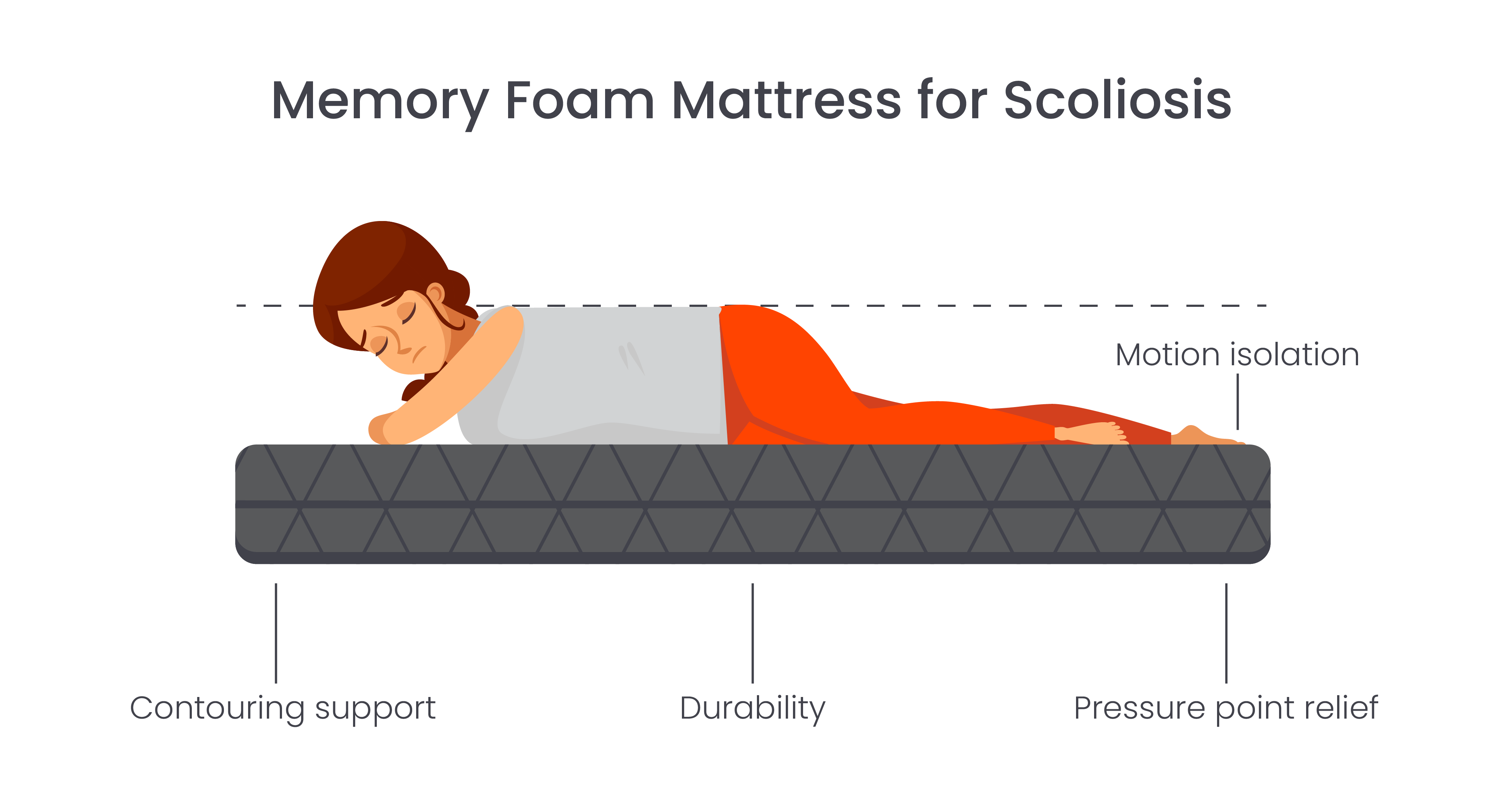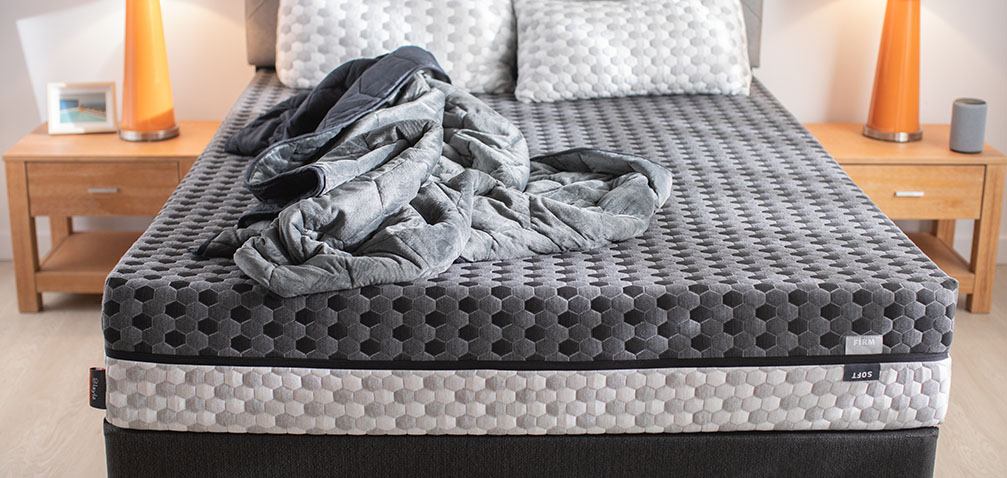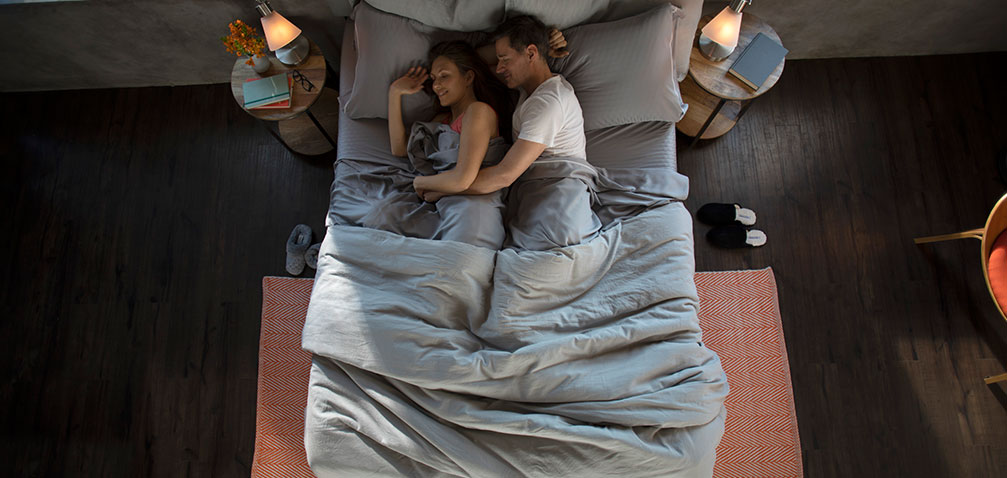In this buying guide, we’ll explore the types to consider when selecting the best mattress for scoliosis and how to alleviate back pain while sleeping. Keep reading to learn more about how to find the best mattress for scoliosis.
- What Is Scoliosis?
- What Is the Best Mattress for Scoliosis?
- What Is the Best Sleeping Position for Scoliosis?
- Tips for Relieving Back Pain When Sleeping
- Wrapping Up: Best Mattresses for Scoliosis
What Is Scoliosis?
Scoliosis is an irregular spine curvature. This condition often involves a spine rotation, resulting in a sideways deviation from the normal vertical alignment, resulting in the spine curving in the shape of an S or C.
Scoliosis can affect anyone, but it’s most common during the growth spurt that occurs just before puberty. The severity of the condition varies, ranging from mild curvature that may not require intervention to more pronounced curvature that can impact overall well-being and cause pain.
There are several types of scoliosis, but the most common is idiopathic scoliosis – meaning the cause of the spine curvature is unknown. In terms of symptoms, mild scoliosis may not cause any noticeable issues. At the same time, moderate to severe cases can lead to visible spinal curvature, uneven shoulders or waist, and potential complications if the curvature affects other parts of the body.
In general, treatment for scoliosis depends on the severity of the curvature, the age of the individual, and the potential for progression. Mild cases may be monitored without immediate intervention, while severe cases may require bracing or surgical correction.
What Is the Best Mattress for Scoliosis?
Scoliosis can cause pain that impacts sleep quality. Individuals with scoliosis often find relief by finding the best mattress and sleeping position for them. A mattress that provides adequate support and aligns with the spine’s natural curvature can improve sleep quality and overall well-being. At the same time, the wrong mattress can affect sleep quality and force you to wake up in pain. When selecting the best mattress for scoliosis, your options include:
Memory Foam Mattresses for Scoliosis
Memory foam mattresses are some of the most popular mattresses for back pain because they offer several key benefits:

- Contouring support: Memory foam molds to the body’s shape, offering personalized and contouring support. This adaptive feature helps maintain a more natural spinal alignment, reducing stress on the spine.
- Motion isolation: Memory foam excels at isolating motion, making it an ideal choice for those with scoliosis who may share their bed with a partner. This quality minimizes disturbances from movements, promoting uninterrupted sleep.
- Durability: High-quality memory foam mattresses are known for their durability, ensuring long-lasting support for individuals dealing with scoliosis.
- Pressure point relief: Scoliosis can lead to increased pressure on the spine. Memory foam’s ability to distribute weight evenly helps alleviate pressure, offering relief to sensitive areas.
- Versatility for different sleeping positions: Memory foam mattresses are versatile and suitable for various sleeping positions, accommodating the unique needs of individuals with scoliosis, whether they sleep on their back, side, or stomach.
Hybrid Mattresses for Scoliosis
With hybrid mattresses, you get the contouring support of memory foam and the additional support of innerspring mattresses. Benefits of hybrid mattresses for scoliosis include:

- Edge support: Hybrid mattresses are renowned for their exceptional edge support. Reinforced edges provide stability and prevent sagging, offering a consistent sleep surface from the center to the edge of the bed. For individuals with scoliosis, edge support ensures a secure and supportive surface, making it easier to sit or lie near the edge without experiencing instability.
- Targeted support: A key feature of hybrid mattresses is the integration of pocketed coil systems. Each coil is individually encased, allowing them to react independently to pressure and conform to the body’s contours. This targeted support is particularly beneficial for individuals with scoliosis as it addresses the unique curves of the spine. Layla’s Variable Support takes this a step further by adjusting the support level based on your weight and position, providing customized support where you need it most.
- Motion isolation: Hybrid mattresses effectively minimize motion transfer. The pocketed coil system, combined with layers of memory foam, absorbs and isolates movements. This ensures that disruptions from a partner’s movements are minimized, promoting a restful night’s sleep for those with scoliosis.
- Pressure point relief: The combination of memory foam and pocketed coils in hybrid mattresses contours the body to distribute your weight evenly and reduce stress in specific areas. This helps alleviate pressure points along the spine and enhances overall comfort during sleep.
- Durability: Hybrid mattresses consist of sturdy innerspring coils and durable foam layers to ensure durability. A durable mattress ensures consistent support over time.
Innerspring Mattresses for Scoliosis
An innerspring mattress has a core support system of steel coils or springs. While these traditional mattresses have their merits, they may not be the best option for those with scoliosis. Compared to memory foam and hybrid mattresses, innerspring mattresses may not be able to effectively address the unique needs of those with scoliosis. The rigidity of the coil system lacks the conforming capabilities that allow it to adapt to the curves of the spine, potentially leading to uneven support and discomfort.
However, innerspring mattresses can still offer benefits for those with scoliosis. They often come in a range of firmness options, allowing you to choose a level of support that aligns with your comfort preferences. Additionally, the open structure of the innerspring mattress promotes airflow, reducing heat retention during sleep. This can be especially beneficial if you sleep hot.
If you already have an innerspring mattress and are reluctant to replace it, you can enhance its comfort for scoliosis by adding a memory foam topper. A mattress topper can provide additional contouring support, adapting to the body’s natural curves and helping to alleviate pressure points.
What Is the Best Sleeping Position for Scoliosis?
Once you’ve found the right mattress, it’s important to find the right sleeping position. While sleeping positions can’t correct scoliosis, they can alleviate discomfort and help you get a better night’s sleep. Layla’s mattresses support a variety of sleeping positions with our flippable firmness that allows you to choose to sleep on a soft or firm mattress.
Some sleeping positions that promote spinal health and can reduce pain associated with scoliosis include:
- Back: Sleeping on your back is often considered the best position for promoting spinal health. This position allows the mattress to provide even support to the natural curvature of the spine. A supportive pillow that maintains proper neck alignment is crucial to ensure the spine remains neutral throughout the night.
- Side sleeping: Sleeping on your side can also promote better sleep while reducing pain. Sleeping with pillows between your knees can help maintain spinal alignment and reduce the stress on your lower back.
Sleeping on your stomach is generally not recommended if you have scoliosis. This position can strain the neck and spine, potentially worsening discomfort. The natural curve of the spine isn’t properly supported in the stomach sleeping position and may contribute to additional stress on the back and neck.
Of course, your personal preference and comfort will also play a role in selecting the right sleeping position for scoliosis. Experimenting with different positions and pillow support can help you find the most comfortable sleep posture.
Tips for Relieving Back Pain When Sleeping
Back pain can significantly impact your overall well-being. Incorporating a combination of exercise, stretching, proper pillow support, and consulting with a healthcare professional can help alleviate back pain and enhance your sleep experience. While these tips don’t cure scoliosis, they can provide some relief:
- Exercise: Regular exercise, particularly activities that strengthen the back muscles, can help individuals with back pain. Building a strong core and back muscle provides better support for the spine, promoting proper alignment and relieving lower back pain.
- Stretch: Before heading to bed, take a few minutes to gently stretch. Focus on stretches that target the back, hamstrings, and hips. These stretches can help loosen tight muscles, improving flexibility and reducing tension in the back. Stretching can also help create a more relaxed state before bed and minimize discomfort during sleep.
- Use the correct pillow: Opt for a pillow with the appropriate loft to maintain proper head, neck, and spine alignment. Memory foam pillows can provide customized support, adapting to the unique contours of your neck and shoulders.
- Consult a healthcare professional: If back pain persists or worsens, guidance from a healthcare professional can help. A physical therapist or orthopedic specialist can thoroughly assess your condition. They can offer personalized advice, recommend specific exercises or interventions, and ensure you’re on the right path.
Wrapping Up: Best Mattresses for Scoliosis
Selecting the right mattress is crucial for individuals with scoliosis who want to find comfort and improve their sleep quality. Layla’s mattresses offer tailored solutions. Whether you choose the contouring support of memory foam or the combined benefits of a hybrid mattress, Layla prioritizes spinal alignment, motion isolation, pressure point relief, and durability. The flippable firmness of our mattress accommodates various sleeping positions, contributing to a more comfortable and supportive night’s sleep. Browse our selection of sleep-enhancing products today.



